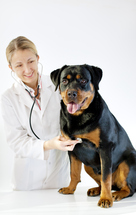Bloat and Torsion
 Bloat and torsion, also known as gastric dilation and volvulus, or GDV, is a life-threatening condition involving distension and abnormal rotation of the stomach. It occurs most often in large animals like horses and in certain large breeds of dogs, but can also occur in smaller dogs and in cats. Bloat and torsion usually manifests in healthy animals in their prime, frequently when they have engaged in vigorous exercise immediately after eating.
Bloat and torsion, also known as gastric dilation and volvulus, or GDV, is a life-threatening condition involving distension and abnormal rotation of the stomach. It occurs most often in large animals like horses and in certain large breeds of dogs, but can also occur in smaller dogs and in cats. Bloat and torsion usually manifests in healthy animals in their prime, frequently when they have engaged in vigorous exercise immediately after eating.
Bloat occurs when the stomach fills with gas, putting pressure on other organs and often restricting breathing. When distended, the stomach can easily rotate on its axis and cut off blood flow, causing rapid necrosis of cells and organ failure. Bloat and torsion can occur independently or together, but in either case emergency surgery is almost always required to save the animal's life.
Causes of Bloat and Torsion
The causes of bloat and torsion in dogs and cats are largely unknown, but genetics and anatomy are believed to play roles in the development of this disorder, since particular large breeds of dogs, such as great Danes, standard poodles and German shepherds are at greater risk, as are dogs with an immediate relative who has had the disorder. Dachshunds are possible victims of this disorder because of their anatomical construction. Excitable temperament and a history of gastrointestinal problems also appear to put animals at greater risk.
Environmental factors also seem to be possible causes of bloat and torsion. These include:
- Ingestion of too much food
- Drinking too much water, especially just after eating
- Delaying bowel movements
- Being too active immediately after eating
Symptoms of Bloat and Torsion
Symptoms of bloat and torsion are not unique to the disorder, but since GDV is often fatal, should never be ignored. These symptoms include:
- Anxious behavior like pacing
- Abdomen distension
- Retching
- Abdominal distention
- Excessive salivation
- Tachycardia (rapid heart beat)
- Dyspnea (labored breathing)
- Weak pulse
- General weakness
- Pale mucus membranes
- Collapse
Diagnosis of Bloat and Torsion
It is possible that symptoms similar to those indicating bloat and torsion may be caused by a bacterial infection, gastroenteritis, or simple overeating, so it is important that the condition be accurately diagnosed before treatment is administered. A physical examination by a veterinarian is necessary and may provide clues to the condition, but bloat and torsion is usually conclusively diagnosed through imaging techniques, such as abdominal X-rays, CT scans or MRIs. Other diagnostic tests for the disorder may include urinalysis and testing for lactate levels in the blood.
Treatment of Bloat and Torsion
Treatment for this emergency condition typically includes releasing gas from the stomach through a tube or large needle in order to stabilize the animal. After stabilization, surgery is usually performed to repair any damage caused by the condition. Sometimes an operation to affix the stomach to the abdominal wall, called a gastropexy, is performed to prevent the problem from reoccurring.
Even after treatment, many animals die from this condition. Depending on how long the condition has existed, there may be a mortality rate of over 50 percent. This is why it's crucial to get veterinary treatment as promptly as possible. The risk of developing bloat and torsion can be decreased by monitoring animals' diet and exercise habits as carefully as possible.
